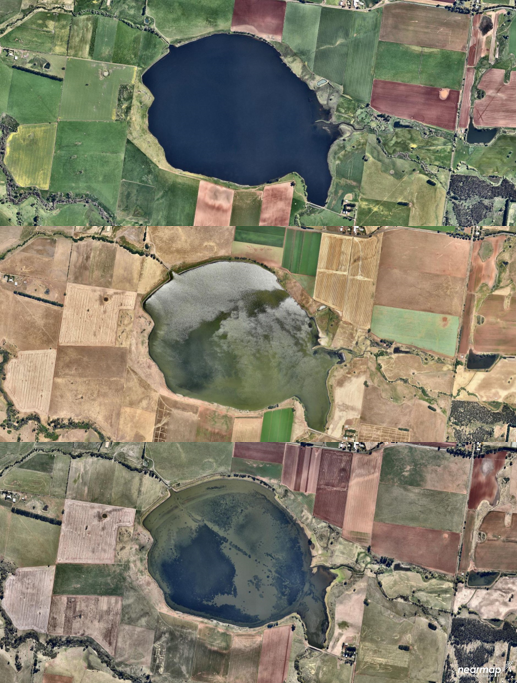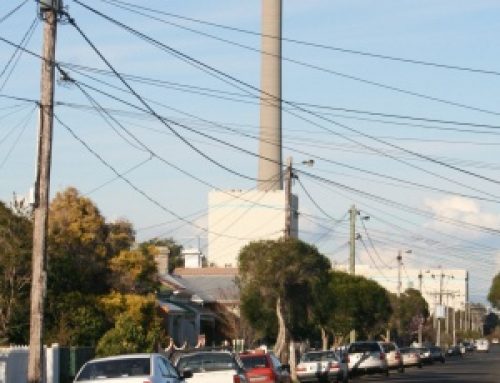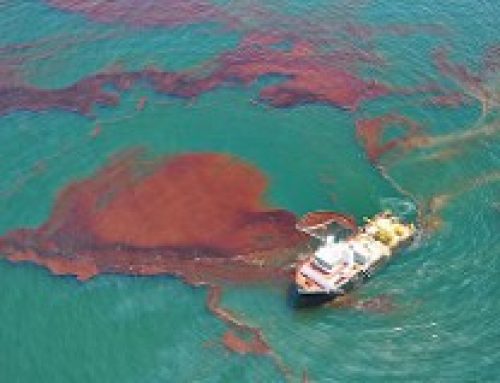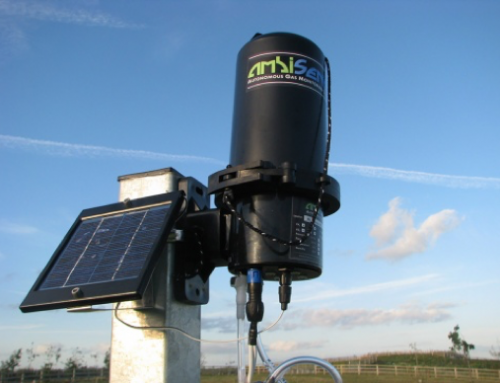The past decade has seen significant advances in algal bloom management technology, with the problem tackled from a range of angles. Arguably the most promising systems are based around the use of flexible waterbody covers, a strategy that is building up a wealth of case studies showing its effectiveness on many levels.
One such technology that has shown immediate results is the AquaArmourTM system. This system is based around the deployment of a fleet of food-grade high density polyethylene (HDPE) free-floating hexagonal pods (Figure 1), and has proven an efficient and effective method for reducing algal blooms formation, not to mention significant reductions in evaporation. Here we will concentrate on the benefits in algal bloom management. The pods are floated on the surface of the waterbody, and due to their self-tessellating design, form a cohesive yet flexible barrier to UV radiation; studies show that 95% of photosynthetically active radiation is prevented from intercepting the waterbody surface. This has the dual effect of reducing the temperature of the waterbody as well as removing the incident light required by the organisms to photosynthesise.


AquaArmourTM had a dramatic effect on raw water storage pond in Gippsland, Victoria. Before the installation the waterbody experienced a series of blooms during a progression of hot summers that were highly conducive to algae growth. These outbreaks meant a majority of the storage volume had to be drained and refilled at large expense in time and money. Following the deployment of the AquaArmourTM units, water temperatures have been consistently and substantially lower (Figure 2) and, critically, there was not a bloom experienced in the following summer post-deployment. An added benefit of the system is the effect it has on bank erosion, with the pods creating an effective baffle to mitigate wave activity. This reduces turbidity and therefore the effect of suspended solids on nutrient levels and reduced water quality.
For more information on the benefits of AquaArmourTM please do not hesitate to contact HydroTerra on:
info@hydroterra.com.au or call us on (03) 8683 0091
Want to take a deeper look?
Read below for an in-depth look at algae management in natural and industrial water storages.
The recent outbreaks of blue-green algae across raw water storages in central Victoria have again brought into focus the disruption this organism can cause to Australia’s reservoirs – both those used in municipal potable water systems as well as industrial catchments. Blue-green algae, despite its name, is in fact an ancient photosynthetic form of bacteria called cyanobacteria. When conditions are right, blue-green algae populations rapidly multiply leading to a state referred to as a bloom. Blooms appear as almost a slick of iridescent green paint across the surface of the water and are often accompanied by a pronounced and unpleasant smell. Aesthetically, blooms can reduce the amenity of a waterway through their unsightly appearance and smell, however the real danger lies in the toxicity of the organism itself. Blue-green algae produces three types of toxins which are harmful to both humans and livestock; hepatoxins, neurotoxins and allergens (CRCWQT 2008). The most common toxin produced by cyanobacteria, saxitoxin, is similar to that of tiger snake venom and can cause severe illness and even death. Therefore, due to the potential severity of blue-green algae exposure, blooms are treated with utmost importance by managers of water storages.

Algal blooms occur when nutrient, light and temperature conditions are sufficient to promote rapid population growth. Cyanobacteria prosper in high light, warm temperatures and high nutrient loads – particularly phosphorous (Smith 1983) – which unfortunately are the classic eutrotrophic conditions found in most perturbed, human-influenced waterways. This is particularly so for small catchments and storage ponds because they have a high bank length to volume ratio, which means they intercept a large amount of run-off compared to the overall volume of the reservoir. Nutrients originate from either direct interception of nutrient rich inflows or from suspended soil matter in the waterbody, particularly clays. The latter is responsible for the often-cited link between turbidity and nutrient level. Therefore, a reduction in bank erosion combined with an increase in semi-aquatic vegetation reduces turbidity and thereby reduces the inflow of these crucial nutrients, especially phosphorous. A comprehensive study of Lake Aimsworth, NSW, following frequent algal blooms in the 1990s, concluded that dune erosion was one of the leading factors contributing to their prevalence (Barret 2010.)
Temperature is another key driver of algal bloom formation. Blue-green algae prefer temperatures above 25°C, a level that can often be reached in standing waterbodies, particularly in shallow sections. In the example below (Figure 2) HydroTerra was engaged to continuously and remotely monitor water temperature in a storage pond (one measurement each day) and discovered readings in excess of 25°C, and even above 35°C, were encountered regularly. Therefore, it comes as no surprise that this waterbody suffers algal blooms on an annual basis.
Algal blooms can have serious economic ramifications especially when the waterbody is providing potable water. Often one of the first indicators of a nascent bloom is the development of unpleasant aromas and taste identified by the downstream consumer of the water, most caused by the compound geosmin. In more serious cases the toxins produced by the blue-green algae can make the water unfit for human and animal consumption. Unfortunately, the cure for an outbreak is often simply time, waiting for water conditions to become less conducive to bacterial growth and then more time for UV light to degrade the ensuing toxin-load in the water. Chemical bacteriocides can be added to control blue-green algae populations, however they can often be more toxic to humans and wildlife than the algae themselves! Therefore, following an outbreak, it is often necessary to supply users with an alternative water source, which in the case of many more remote communities can mean trucking water in for distribution. The speed in which blooms emerge in town water sources was illustrated in Hepburn Lagoon, Victoria (Figure 1), which has an ongoing blue-green algae issue at the time of publication, 7 months after it first emerged (Figure 3.) Compounding the inconvenience and the expense, is the simple fact that in many locations a particular water storage may be the only water available. For example, it is not uncommon for water storages to be filled irregularly and opportunistically by pumping from ephemeral water sources, for example creeks. This means for much of the year, in these areas water is very much a finite resource. Therefore, it is often economical and prudent to investigate possible mechanical steps to prevent future outbreaks.
The past decade has seen significant advances in algal bloom management technology, with the problem tackled from a range of angles. Arguably the most promising systems is based around the use of flexible waterbody covers, a strategy that is building up a wealth of case studies showing its effectiveness on many levels. One such technology that has shown immediate results is the AquaArmourTM system. This system is based around the deployment of a fleet of food-grade high density polyethylene (HDPE) free-floating hexagonal pods (Figure 4), and has proven an efficient and effective method for reducing algal blooms formation, not to mention significant reductions in evaporation. Here we will concentrate on the benefits in bloom management. The pods are floated on the surface of the waterbody, and due to their self-tessellating design, form a cohesive yet flexible barrier to UV radiation; studies show that 95% of photosynthetically active radiation is prevented from intercepting the waterbody surface. This has the dual effect of reducing the temperature of the waterbody as well as removing the incident light required by the organisms to photosynthesise.


Figure 4: the exploded structure of an AquaArmour pod
AquaArmourTM had a dramatic effect on raw water storage pond in Heyfield, Victoria, an installation commissioned by Gippsland Water. Before the installation the waterbody suffered 2 – 3 algal blooms annually, which meant the entire volume had to be drained and then refilled at large expense. Following the deployment of the AquaArmourTM units, water temperatures have been consistently and substantially lower (Figure 5) and, critically, there has not been another recorded bloom. An added benefit of the system is the effect it has on bank erosion, with the pods creating an effective baffle to mitigate wave activity. This reduces turbidity and therefore the effect of suspended solids on nutrient levels and reduced water quality.
Figure 5: The temperature profile of a storage pond, with AquaArmour installed, between October and December (Top), showing more stable and lower water temperatures than the uncovered waterbody (Bottom)
For more information on the benefits of AquaArmourTM please do not hesitate to contact HydroTerra on
(03) 8683 0091
References:
Barret, H. (2014) Causes, effects and management of ‘blue green algae’ cyanobacteria and their harmful algal blooms in Australian recreation and drinking water with two Ballina, NSW, case studies. www.science20.com, accessed 21/7/17
CRC for Water Quality and Treatment (2008) Blue Green Algae: A Guide, Series: Drinking Water Facts, Issue 3
Goulburn-Murray Water (2017) Blue-green algae, http://www.g-mwater.com.au/bluegreenalgae-alert/, accessed 24/7/17
Smith, V (1983) Low nitrogen to phosporous ratios favour dominance by blue-green algae in lake phytoplankton. Science, 221(4611): 669 – 671
![Environmental Monitoring Services [HydroTerra] Logo](http://environmentalmonitoringservices.com.au/wp-content/uploads/2019/07/HydroTerra-Logo-White-500X112.png)





Leave A Comment